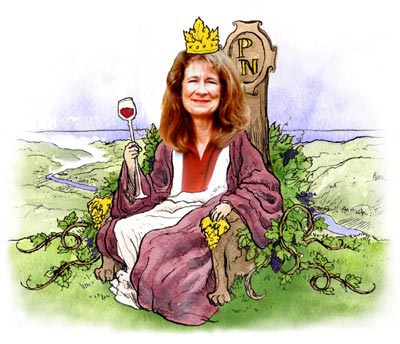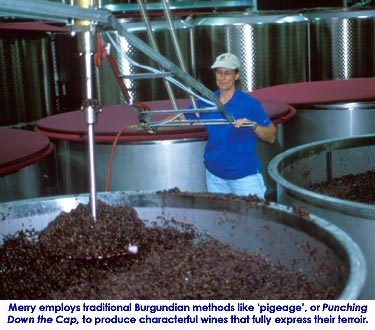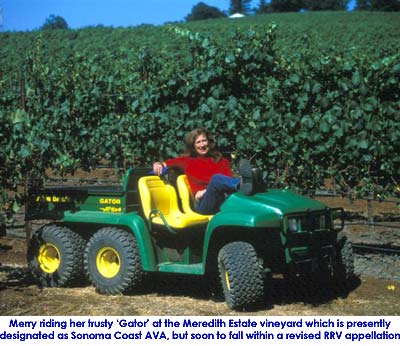

Merry Edwards, the Queen of Pinot, presides over a land called Russian River Valley
"Since the first Russian River Valley petition was filed 20 years ago, we have come to understand that the fog line is the most important factor defining our region."
by
Adam Dial
May 13, 2004
AA:
Merry, you studied at Davis and chummed around with Steve MacRostie
(see Appellation Advocate feature for the Carneros AVA)
in the mid 1970’s. Back then the great California Pinot Noir was still a largely undiscovered creature. However, almost three decades later, you’re known as the “Queen of Pinot”, and Steve, if not the "King", is certainly "Chief Clansman" for the Carneros appellation. The two of you are also at the head of your respective appellation associations (RRVW and CQA). Today, when you and Steve get together, how do you compare notes, not about who’s Pinot (and region) is better, but how they are 'distinctive' from one another? ...After all, the only thing better than a world of just Pinot, is a world diverse with many unique and individual Pinots. (at least this has been the case in Burgundy’s Cote-d’Or for centuries!)
ME: Steve can best describe Carneros. However, I can make some distinctions. The Carneros region is cooler than Russian River Valley (RRV) in general. It is very close to the Bay and has a true marine influence. RRV is somewhat warmer and receives its cooling influence from the fog which surrounds the area. The fog travels up the river from the Pacific Ocean and also moves north from the Bay.
The soils are also quite different. In Carneros there is a distinct soil series which contains a type of very black clay. In RRV the soils are more sandy, with a high proportion of the Goldridge series being found there. The high sand content gives the region excellent drainage.
The wines from Carneros typically show bright red fruit characters like strawberry, Queen Anne cherry & red raspberry along with a lively acidity and a sleek palate. RRV Pinot, on the otherhand, shows more dark fruits like plum, Bing cherry, blackberry or black raspberry, along with cola and a bit of earthiness. The wines have a dense palate that is the hallmark of our area.
AA: You are well known for your work with clonal selection of Pinot Noir. For the Russian River Valley, do you see the use of various clones as a stylistic choice for the winemaker, with an artistic rational? Or is clonal selection a matter of best suiting the vine to its environment with a more ecological objective? Put another way, does the greatest value of clonal selection lie in creating a wealth of Pinot styles, or in finding a wider range of viable growing conditions for the variety?
ME: I feel that the use of multiple clones gives diversity & complexity, especially in a single site. Additionally, a particular clone may suit a specific site exceptionally well. Many people plant multiple clones in a single site to determine what will work best for them. As the Dijon clones are relatively new (”editions” still being released from France), this is a work in progress. Each winemaker will certainly have his/her favourites among the classic California, Oregon and Dijon clones.
AA: Pinot Noir has long been tagged as the difficult one and the heartbreak grape. Admittedly, the darn thing does present challenges to growers and winemakers that other, less finicky varieties don’t. However, it almost seems that people were looking for excuses for all the failures with the variety in California. Do you think that the great California Pinot would have become more commonplace earlier, had we had a better understanding and appreciation of the importance of clones a few decades ago?
ME: I feel that there are many factors which determined our “late start” with Pinot Noir. Clones certainly are a factor, since there was some very poor material in the ground. With the realization that clones and selections make a true difference, especially in Pinot Noir, there has been a weeding out of poor material. We cannot deny the important influence of the new Dijon clones; however, some of the great Pinots in California are made from mature vineyards of older selections.
 In my mind, the most important factor in improving Pinot Noir in America was the formation of the Pinot Noir Technical Symposium (in conjunction with the
International Pinot Noir Celebration). This group was started more than twenty years ago and is still hosted by Oregon winemakers at the Steamboat Lodge in Oregon. This symposium brings together Pinot Noir winemakers from all over the world whose passion has been, and continues to be, the elevation of quality. The creation of this “brain trust” has catapulted Pinot Noir to a new position in the world market, leapfrogging this varietal ahead of Merlot and Syrah. Improvements in vineyard practices, understanding microclimates appropriate for Pinot Noir cultivation, changes in winemaking techniques and clonal selection have all been important in this process.
In my mind, the most important factor in improving Pinot Noir in America was the formation of the Pinot Noir Technical Symposium (in conjunction with the
International Pinot Noir Celebration). This group was started more than twenty years ago and is still hosted by Oregon winemakers at the Steamboat Lodge in Oregon. This symposium brings together Pinot Noir winemakers from all over the world whose passion has been, and continues to be, the elevation of quality. The creation of this “brain trust” has catapulted Pinot Noir to a new position in the world market, leapfrogging this varietal ahead of Merlot and Syrah. Improvements in vineyard practices, understanding microclimates appropriate for Pinot Noir cultivation, changes in winemaking techniques and clonal selection have all been important in this process.
AA: When the RRV AVA was first petitioned back in 1983, the boundaries were based on existing vineyards. Your vineyard, Meredith Estate, was planted subsequent to AVA approval and is located in the Sonoma Coast appellation, lying just outside the RRV boundaries. Since your location experiences the same fog and cooling coastal effects as the rest of the RRV, you are working to have the RRV boundaries broadened to include your site. Does the current revision petition include other new vineyard areas?

ME: The petition filed by the Russian River Valley Winegrowers in January of 2003 seeks to include all areas which lie within fog influence, but which were previously excluded from the RRV AVA. Since the first petition was filed 20 years ago, we have come to understand that the fog line is the most important factor defining our region. The newly revised RRV AVA will include the Sebastopol Hill area south of the current boundary (where Meredith Estate is located). It will also encompass the remainder of Santa Rosa Plain which was bisected in the original AVA. We anticipate our current petition reaching the public comment stage sometime during the summer of 2004.
AA: Continuing with appellation boundaries, the value of appellation-of-origin is not just in its guarantee of where a wine comes from, but also its assurance of a signature style based on that named origin. If RRV is trying to develop world recognition for the finest Pinot Noir, do you think that the original boundaries of 20 years ago are consistent with this current objective? For example, do you believe the original AVA lines were drawn out to include existing vineyards which were well suited to other varieties, and not specifically to Pinot Noir? If so, would it be reasonable to consider boundary revision to exclude such areas, for the sake of a meaningful appellation defined by consistent growing conditions based on the suitability for Pinot Noir? (Areas in question: the appellation’s northern extreme which overlaps Alexander Valley, and the soil/climatically different Chalk Hil
ME: Steve can best describe Carneros. However, I can make some distinctions. The Carneros region is cooler than Russian River Valley (RRV) in general. It is very close to the Bay and has a true marine influence. RRV is somewhat warmer and receives its cooling influence from the fog which surrounds the area. The fog travels up the river from the Pacific Ocean and also moves north from the Bay.
The soils are also quite different. In Carneros there is a distinct soil series which contains a type of very black clay. In RRV the soils are more sandy, with a high proportion of the Goldridge series being found there. The high sand content gives the region excellent drainage.
The wines from Carneros typically show bright red fruit characters like strawberry, Queen Anne cherry & red raspberry along with a lively acidity and a sleek palate. RRV Pinot, on the otherhand, shows more dark fruits like plum, Bing cherry, blackberry or black raspberry, along with cola and a bit of earthiness. The wines have a dense palate that is the hallmark of our area.
AA: You are well known for your work with clonal selection of Pinot Noir. For the Russian River Valley, do you see the use of various clones as a stylistic choice for the winemaker, with an artistic rational? Or is clonal selection a matter of best suiting the vine to its environment with a more ecological objective? Put another way, does the greatest value of clonal selection lie in creating a wealth of Pinot styles, or in finding a wider range of viable growing conditions for the variety?
ME: I feel that the use of multiple clones gives diversity & complexity, especially in a single site. Additionally, a particular clone may suit a specific site exceptionally well. Many people plant multiple clones in a single site to determine what will work best for them. As the Dijon clones are relatively new (”editions” still being released from France), this is a work in progress. Each winemaker will certainly have his/her favourites among the classic California, Oregon and Dijon clones.
AA: Pinot Noir has long been tagged as the difficult one and the heartbreak grape. Admittedly, the darn thing does present challenges to growers and winemakers that other, less finicky varieties don’t. However, it almost seems that people were looking for excuses for all the failures with the variety in California. Do you think that the great California Pinot would have become more commonplace earlier, had we had a better understanding and appreciation of the importance of clones a few decades ago?
ME: I feel that there are many factors which determined our “late start” with Pinot Noir. Clones certainly are a factor, since there was some very poor material in the ground. With the realization that clones and selections make a true difference, especially in Pinot Noir, there has been a weeding out of poor material. We cannot deny the important influence of the new Dijon clones; however, some of the great Pinots in California are made from mature vineyards of older selections.
 In my mind, the most important factor in improving Pinot Noir in America was the formation of the Pinot Noir Technical Symposium (in conjunction with the
International Pinot Noir Celebration). This group was started more than twenty years ago and is still hosted by Oregon winemakers at the Steamboat Lodge in Oregon. This symposium brings together Pinot Noir winemakers from all over the world whose passion has been, and continues to be, the elevation of quality. The creation of this “brain trust” has catapulted Pinot Noir to a new position in the world market, leapfrogging this varietal ahead of Merlot and Syrah. Improvements in vineyard practices, understanding microclimates appropriate for Pinot Noir cultivation, changes in winemaking techniques and clonal selection have all been important in this process.
In my mind, the most important factor in improving Pinot Noir in America was the formation of the Pinot Noir Technical Symposium (in conjunction with the
International Pinot Noir Celebration). This group was started more than twenty years ago and is still hosted by Oregon winemakers at the Steamboat Lodge in Oregon. This symposium brings together Pinot Noir winemakers from all over the world whose passion has been, and continues to be, the elevation of quality. The creation of this “brain trust” has catapulted Pinot Noir to a new position in the world market, leapfrogging this varietal ahead of Merlot and Syrah. Improvements in vineyard practices, understanding microclimates appropriate for Pinot Noir cultivation, changes in winemaking techniques and clonal selection have all been important in this process.
AA: When the RRV AVA was first petitioned back in 1983, the boundaries were based on existing vineyards. Your vineyard, Meredith Estate, was planted subsequent to AVA approval and is located in the Sonoma Coast appellation, lying just outside the RRV boundaries. Since your location experiences the same fog and cooling coastal effects as the rest of the RRV, you are working to have the RRV boundaries broadened to include your site. Does the current revision petition include other new vineyard areas?

ME: The petition filed by the Russian River Valley Winegrowers in January of 2003 seeks to include all areas which lie within fog influence, but which were previously excluded from the RRV AVA. Since the first petition was filed 20 years ago, we have come to understand that the fog line is the most important factor defining our region. The newly revised RRV AVA will include the Sebastopol Hill area south of the current boundary (where Meredith Estate is located). It will also encompass the remainder of Santa Rosa Plain which was bisected in the original AVA. We anticipate our current petition reaching the public comment stage sometime during the summer of 2004.
AA: Continuing with appellation boundaries, the value of appellation-of-origin is not just in its guarantee of where a wine comes from, but also its assurance of a signature style based on that named origin. If RRV is trying to develop world recognition for the finest Pinot Noir, do you think that the original boundaries of 20 years ago are consistent with this current objective? For example, do you believe the original AVA lines were drawn out to include existing vineyards which were well suited to other varieties, and not specifically to Pinot Noir? If so, would it be reasonable to consider boundary revision to exclude such areas, for the sake of a meaningful appellation defined by consistent growing conditions based on the suitability for Pinot Noir? (Areas in question: the appellation’s northern extreme which overlaps Alexander Valley, and the soil/climatically different Chalk Hil














